Abstract
It is not possible to select one competing substrate molecule over another one when the selection system is at equilibrium. Therefore, it is convenient to view all substrate selections as transport phenomena. The requirement for a displacement from equilibrium to effect a substrate selection can be met in different ways. One particularly convenient way is to drive a nonselected substrate, such as GTP in protein synthesis, far from equilibrium. This allows the flux of selected substrate to be relatively slow, but effectively irreversible. Accordingly, the conventional view that GTP hydrolysis drives protein synthesis is amended. It is suggested that the regeneration GTP from GDP is the driving force for protein synthesis. Several different selection mechanisms are described in the context fof systems driven by displacements from equilibrium of the nonselected substrate. These are then evaluated in light of recent experimental results. The data argue against the relevance of proofreading mechanisms for aminoacyl-tRNA selection by the messenger RNA-programmed ribosome. Similarly, recent data suggesting that the translation of messenger RNA is not dependent on the presence of elongation factors and guanine nucleotides are reevaluated.
Full text
PDF
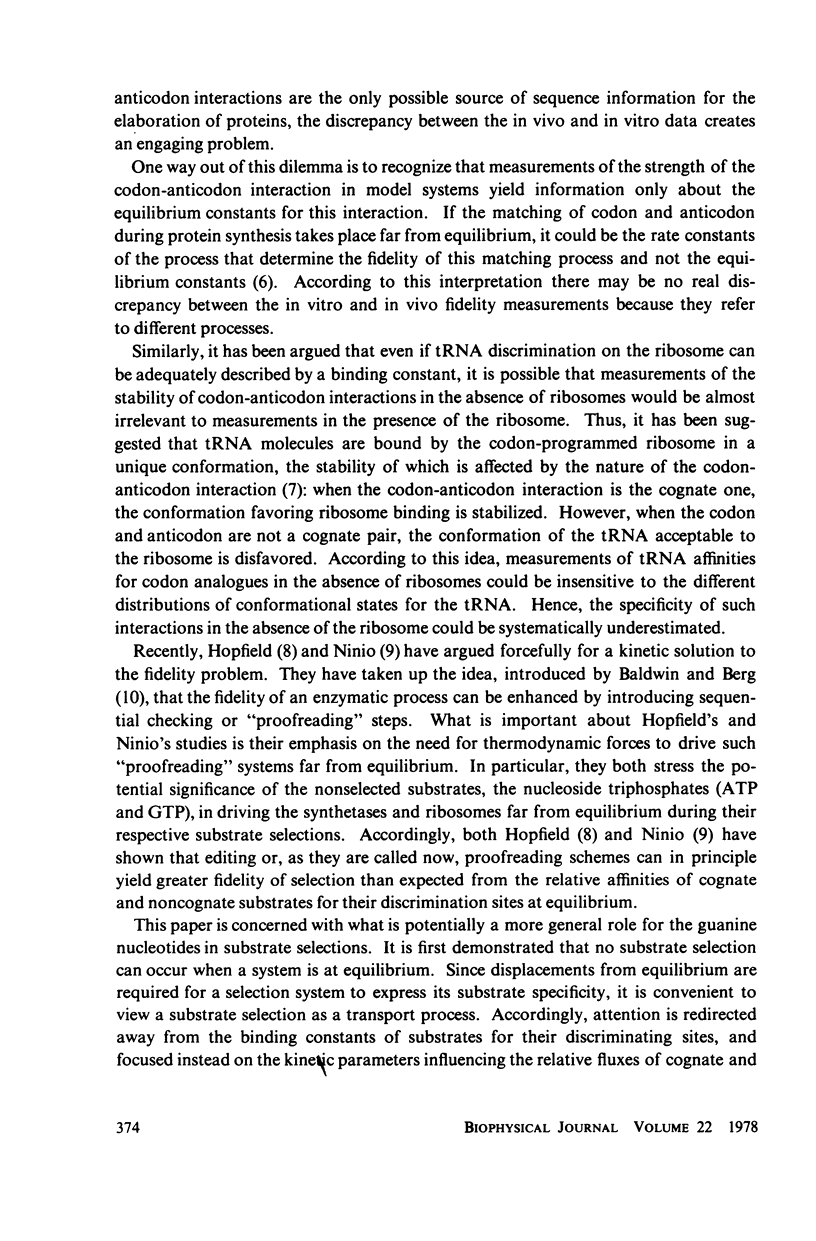

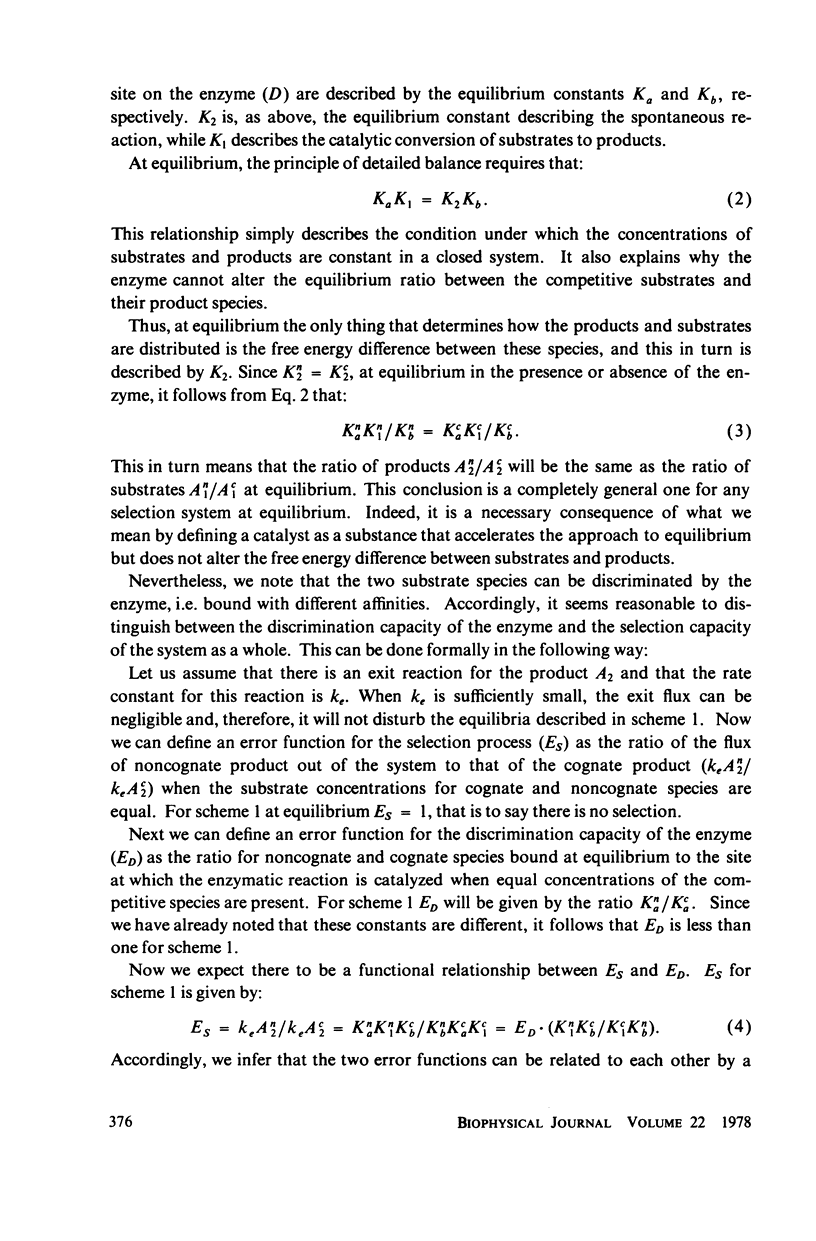









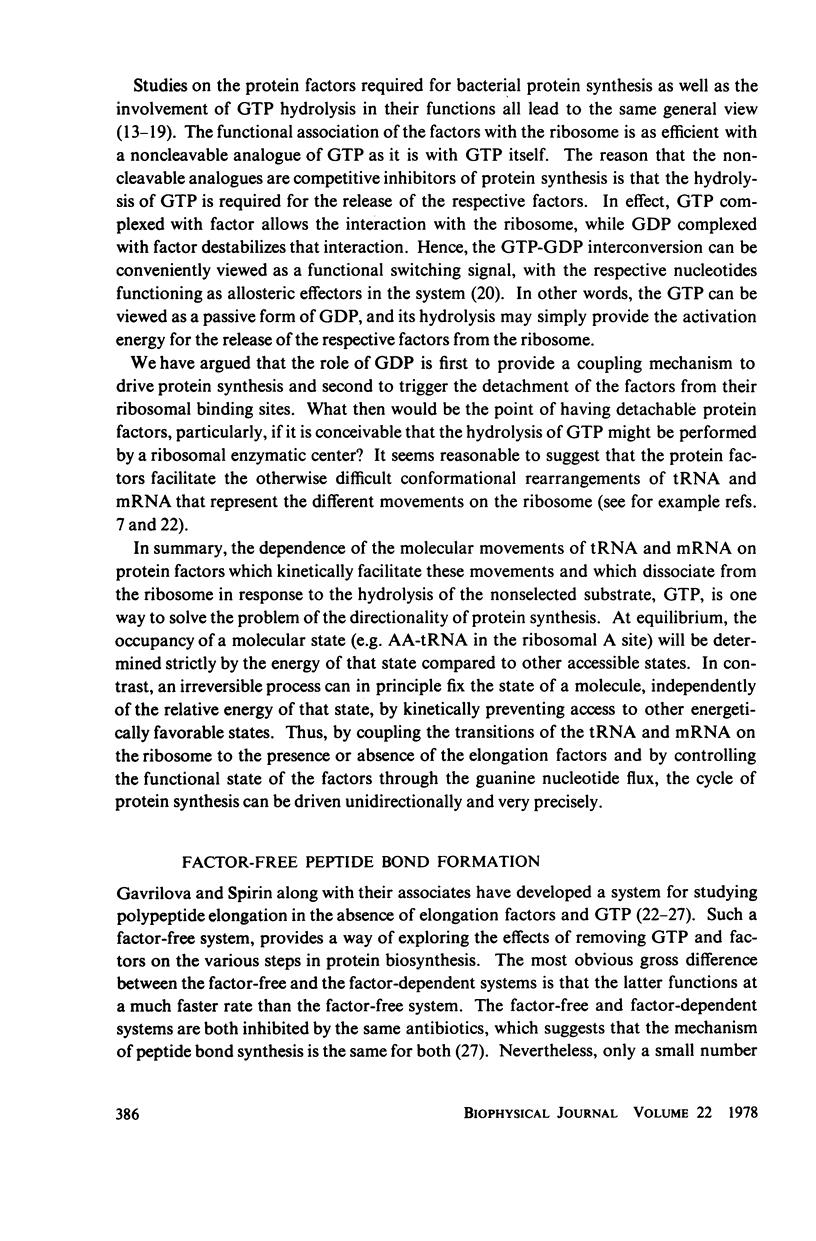


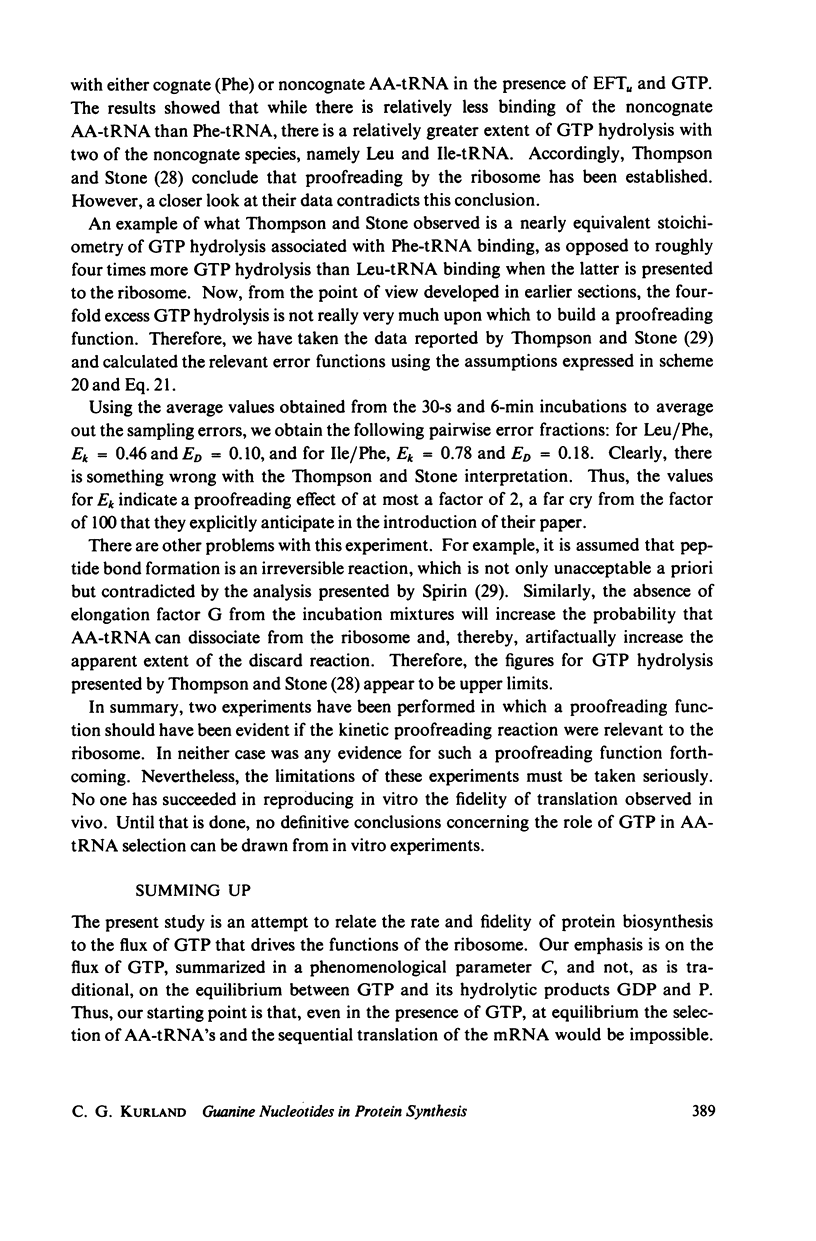


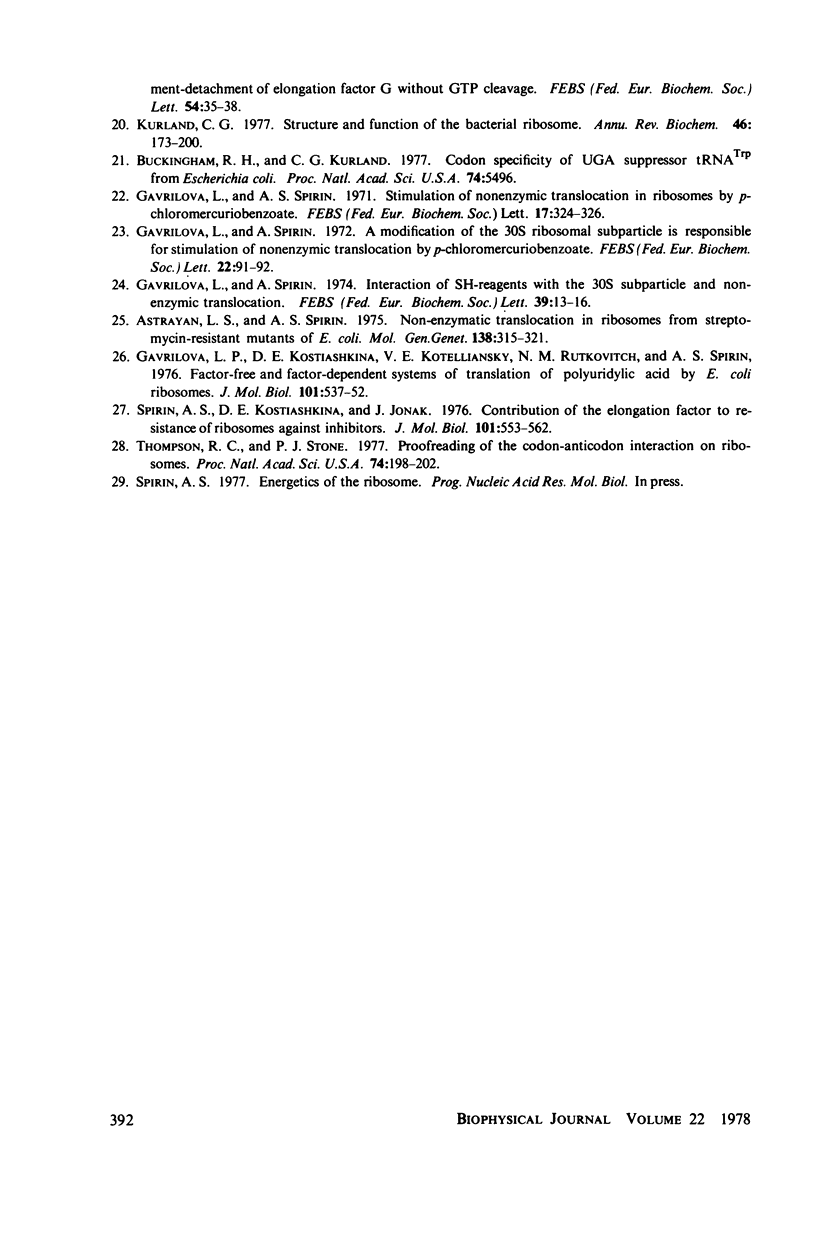
Selected References
These references are in PubMed. This may not be the complete list of references from this article.
- Asatryan L. S., Spirin A. S. Non-enzymatic translocation in ribosomes from streptomycin-resistant mutants of Escherichia coli. Mol Gen Genet. 1975 Jul 10;138(4):315–321. doi: 10.1007/BF00264801. [DOI] [PubMed] [Google Scholar]
- Bagnara A. S., Finch L. R. Relationships between intracellular contents of nucleotides and 5-phosphoribosyl 1-pyrophosphate in Escherichia coli. Eur J Biochem. 1973 Jul 16;36(2):422–427. doi: 10.1111/j.1432-1033.1973.tb02927.x. [DOI] [PubMed] [Google Scholar]
- Baldwin A. N., Berg P. Transfer ribonucleic acid-induced hydrolysis of valyladenylate bound to isoleucyl ribonucleic acid synthetase. J Biol Chem. 1966 Feb 25;241(4):839–845. [PubMed] [Google Scholar]
- Benne R., Voorma H. O. Entry site of formylmethionyl-tRNA. FEBS Lett. 1972 Feb 15;20(3):347–351. doi: 10.1016/0014-5793(72)80104-2. [DOI] [PubMed] [Google Scholar]
- Buckingham R. H., Kurland C. G. Codon specificity of UGA suppressor tRNATrp from Escherichia coli. Proc Natl Acad Sci U S A. 1977 Dec;74(12):5496–5498. doi: 10.1073/pnas.74.12.5496. [DOI] [PMC free article] [PubMed] [Google Scholar]
- CRICK F. H. On protein synthesis. Symp Soc Exp Biol. 1958;12:138–163. [PubMed] [Google Scholar]
- Coutsogeorgopoulos C., Fico R., Miller J. T. On the function of guanosine triphosphate in the formation of N-acetyl-phenylalanyl puromycin. Biochem Biophys Res Commun. 1972 Jun 9;47(5):1056–1062. doi: 10.1016/0006-291x(72)90940-0. [DOI] [PubMed] [Google Scholar]
- Dubnoff J. S., Maitra U. Characterization of the ribosome-dependent guanosine triphosphatase activity of polypeptide chain initiation factor IF 2. J Biol Chem. 1972 May 10;247(9):2876–2883. [PubMed] [Google Scholar]
- Edelmann P., Gallant J. Mistranslation in E. coli. Cell. 1977 Jan;10(1):131–137. doi: 10.1016/0092-8674(77)90147-7. [DOI] [PubMed] [Google Scholar]
- Gavrilova L. P., Kostiashkina O. E., Koteliansky V. E., Rutkevitch N. M., Spirin A. S. Factor-free ("non-enzymic") and factor-dependent systems of translation of polyuridylic acid by Escherichia coli ribosomes. J Mol Biol. 1976 Mar 15;101(4):537–552. doi: 10.1016/0022-2836(76)90243-6. [DOI] [PubMed] [Google Scholar]
- Gavrilova L. P., Spirin A. S. A modification of the 30 S ribosomal subparticle is responsible for stimulation of "non-enzymatic" translocation by p-chloromercuribenzoate. FEBS Lett. 1972 Apr 15;22(1):91–92. doi: 10.1016/0014-5793(72)80227-8. [DOI] [PubMed] [Google Scholar]
- Gavrilova L. P., Spirin A. S. Interaction of SH-reagents with the ribosomal 30 S subparticle and 'non-enzymatic' translocation. FEBS Lett. 1974 Feb 1;39(1):13–16. doi: 10.1016/0014-5793(74)80005-0. [DOI] [PubMed] [Google Scholar]
- Gavrilova L. P., Spirin A. S. Stimulation of "non-enzymic" translocation in ribosomes by p-chloromercuribenzoate. FEBS Lett. 1971 Oct 1;17(2):324–326. doi: 10.1016/0014-5793(71)80177-1. [DOI] [PubMed] [Google Scholar]
- Grosjean H., Söll D. G., Crothers D. M. Studies of the complex between transfer RNAs with complementary anticodons. I. Origins of enhanced affinity between complementary triplets. J Mol Biol. 1976 May 25;103(3):499–519. doi: 10.1016/0022-2836(76)90214-x. [DOI] [PubMed] [Google Scholar]
- Hopfield J. J. Kinetic proofreading: a new mechanism for reducing errors in biosynthetic processes requiring high specificity. Proc Natl Acad Sci U S A. 1974 Oct;71(10):4135–4139. doi: 10.1073/pnas.71.10.4135. [DOI] [PMC free article] [PubMed] [Google Scholar]
- Inoue-Yokosawa N., Ishikawa C., Kaziro Y. The role of guanosine triphosphate in translocation reaction catalyzed by elongation factor G. J Biol Chem. 1974 Jul 10;249(13):4321–4323. [PubMed] [Google Scholar]
- Kurland C. G. Ribosome structure and function emergent. Science. 1970 Sep 18;169(3951):1171–1177. doi: 10.1126/science.169.3951.1171. [DOI] [PubMed] [Google Scholar]
- Kurland C. G., Rigler R., Ehrenberg M., Blomberg C. Allosteric mechanism for codon-dependent tRNA selection on ribosomes. Proc Natl Acad Sci U S A. 1975 Nov;72(11):4248–4251. doi: 10.1073/pnas.72.11.4248. [DOI] [PMC free article] [PubMed] [Google Scholar]
- Kurland C. G. Structure and function of the bacterial ribosome. Annu Rev Biochem. 1977;46:173–200. doi: 10.1146/annurev.bi.46.070177.001133. [DOI] [PubMed] [Google Scholar]
- Loftfield R. B., Vanderjagt D. The frequency of errors in protein biosynthesis. Biochem J. 1972 Aug;128(5):1353–1356. doi: 10.1042/bj1281353. [DOI] [PMC free article] [PubMed] [Google Scholar]
- Lucas-Lenard J. Protein biosynthesis. Annu Rev Biochem. 1971;40:409–448. doi: 10.1146/annurev.bi.40.070171.002205. [DOI] [PubMed] [Google Scholar]
- Ninio J. Kinetic amplification of enzyme discrimination. Biochimie. 1975;57(5):587–595. doi: 10.1016/s0300-9084(75)80139-8. [DOI] [PubMed] [Google Scholar]
- Spirin A. S., Kostiashkina O. E., Jonák J. Contribution of the elongation factors to resistance of ribosomes against inhibitors: comparison of the inhibitor effects on the factor-free translation systems. J Mol Biol. 1976 Mar 15;101(4):553–562. doi: 10.1016/0022-2836(76)90244-8. [DOI] [PubMed] [Google Scholar]
- Tate W. P., Beaudet A. L., Caskey C. T. Influence of guanine nucleotides and elongation factors on interaction of release factors with the ribosome. Proc Natl Acad Sci U S A. 1973 Aug;70(8):2350–2355. doi: 10.1073/pnas.70.8.2350. [DOI] [PMC free article] [PubMed] [Google Scholar]
- Thompson R. C., Stone P. J. Proofreading of the codon-anticodon interaction on ribosomes. Proc Natl Acad Sci U S A. 1977 Jan;74(1):198–202. doi: 10.1073/pnas.74.1.198. [DOI] [PMC free article] [PubMed] [Google Scholar]
- Yokosawa H., Inoue-Yokosawa N., Arai K. I., Kawakita M., Kaziro Y. The role of guanosine triphosphate hydrolysis in elongation factor Tu-promoted binding of aminoacyl transfer ribonucleic acid to ribosomes. J Biol Chem. 1973 Jan 10;248(1):375–377. [PubMed] [Google Scholar]


